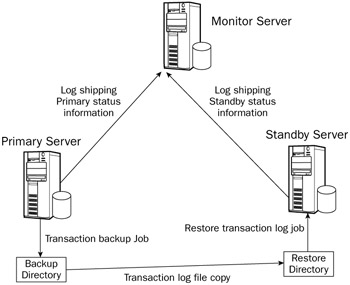Log-Shipping Architecture
The basic log-shipping architecture is shown in Figure 19-1. The architecture requires three servers: A primary server, a secondary server (also known as the standby server), and an optional monitor server.

Figure 19-1
Primary Server
The primary server is the production server that users connect to do work, and it holds the SQL Server 2005 instance that needs to be protected in case of hardware failure, software error, natural disaster, or user-induced errors. In log shipping, the primary server is configured to execute a SQL Agent job to back up the transaction log to a file. For log shipping to function, the server must be using the database recovery models of either Bulk Logged or Full. (See the Database Properties using SQL Server 2005 Management Studio.)
Secondary Server
The secondary server is the standby SQL Server 2005 instance that maintains a copy of the primary server database for high availability. The secondary server uses the SQL Agent to copy the transaction-log file from the backup folder where it was placed by the primary server's transaction-log backup to restore it. The secondary server is configured with two SQL Agent jobs: one to copy the transaction-log file from the backup folder and the other to restore the transaction log. For log shipping to function, it must be using the database recovery models of either Bulk Logged or Full. This server should have similar performance specifications to those of the primary server, to maintain consistent user experience during failover.
Monitor Server
Having a monitor server as part of log shipping is optional but is recommended. The monitor server should be a different physical server to prevent it from becoming a single point of failure from the primary or standby server. When the monitor server participates in log shipping, it manages the jobs that produce monitoring information, such as the last time the transaction log was backed up on the primary server, the last transaction log that was restored on the standby server, and the time deltas between the processes. The monitor server will also send alerts to page or e-mail the operator when log-shipping thresholds are crossed. A single Monitor Server can monitor multiple log-shipping environments. Without a monitor server, the primary and standby servers assume the monitoring duties.
EAN: 2147483647
Pages: 193